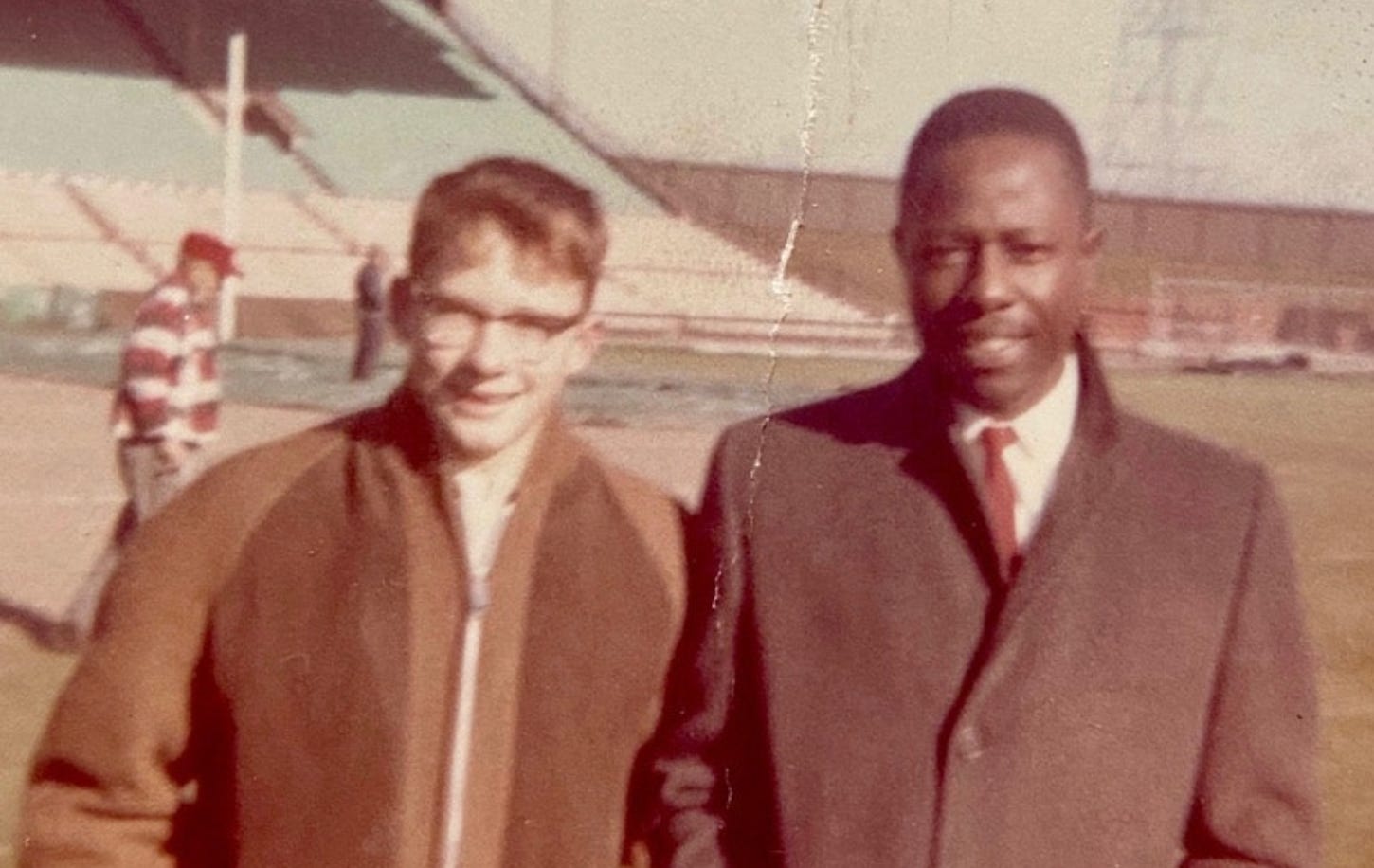Notable Sandwiches #17: The Bratwurst
The best of sausages for the wurst of times.
Edited by Talia Lavin
Welcome to the latest installment of Notable Sandwiches, where my editor and I nibble through the magnificent and confounding document that is Wikipedia’s List of Notable Sandwiches, in alphabetical order. This week, I’m handing over the reins to my beloved editor David Swanson, whose paternal roots in Wisconsin and lifelong love of bratwurst make him the authority. Until next week, when we examine the Irish breakfast roll.
One of my father’s earliest memories of growing up in Wisconsin—or, in any case, one of the most vivid—was eating his first bratwurst at Milwaukee’s County Stadium in 1957. He was nine years old. If you know anything about baseball history, you’ll appreciate the significance of 1957 in Milwaukee. That was the year that the Braves—led by Warren Spahn, Eddie Mathews, and my dad’s hero, Henry Aaron—defeated the hated Yankees to win the World Series. And my father was there, with my uncle and grandfather, the first time he’d seen his beloved Braves in person. “The fact that it was a World Series game didn’t hit me that powerfully, but I remember that brat,” he says today. “We were getting stuff to eat, and I wanted a hot dog, but Grandpa said, ‘Why don’t you try a bratwurst?’ I think it was the first time I’d ever had one, and it was just unbelievably good. Like a little epiphany.” My father recently retired after over forty years in the Episcopal Church, so he had more epiphanies to come.

While I can’t claim my own Damascene bratwurst revelation, it is probably the entry on Wikipedia’s List of Notable Sandwiches that I’ve eaten more often than any other, and it’s the food I most associate with my dad. Growing up, I ate brats the way other kids ate hot dogs: often, and with relish (not the condiment.) It remains a staple of my diet to this day, cholesterol, blood pressure, and waistline notwithstanding. While my dad is a child of Wisconsin, I’m a New York kid who has spent his life rooting for those hated Yankees, so my go-to ballpark food is an Italian sausage with onions and peppers. But much like rooting for the Green Bay Packers and UW Badgers and supporting progressive politics, I was taught that the brat was something of a Wisconsin birthright.
The first recorded mention of the bratwurst—from the high German for “chopped meat” (brät) and “sausage” (wurst)—came on September 13, 1313, when the Nuremberg City Council set down on parchment a new regulation dictating that only meat from the pork loin could be used in the production of local sausages. Today, the bratwurst comes in all shapes and sizes. The version served in modern Nuremberg is closer in size to a cocktail weeny than what we’re used to in America: it’s about the size of a finger, and served a dozen at a time, usually with sauerkraut and potato salad on a pewter platter. The Fränkische Bratwurst is similar to its Nürnberger cousin, but longer, with a ground pork mixture heavy on the marjoram. First documented at the relatively recent date of 1498, Coburg bratwursts are roughly 10 inches in length, contains at least 15% beef and veal, are seasoned with salt, pepper, nutmeg, and lemon zest, and are grilled over pine cones. In Thuringia, the specialty since 1404 has been rostbratwurst, a spicier variety seasoned with salt, pepper, carraway, marjoram, and garlic, and cooked over charcoal. All told, there are some 50 varieties available in Germany.
The bratwurst arrived in Wisconsin in the middle of the 19th century with a surge of German immigrants fleeing the political unrest of 1848, the same Germans who helped make Milwaukee the brewing capital of America, and polka the leading art form of the Upper Midwest. Though the Wisconsin brat is more regionally consistent than its German counterpart, there is by no means a standard recipe for the sausage itself, nor its preparation and presentation. At Milwaukee Brewers games, the brats come dressed in the “Secret Stadium Sauce.” At State Street Brats in Madison, they favor a beefy “red” bratwurst. Up north in Green Bay, tailgaters at Lambeau Field simmer their brats in beer, butter, mustard and onions before throwing them on the grill (my favored method). My dad, meanwhile, swears by Usinger’s in Milwaukee.
In Sheboygan, so-called “Bratwurst Capital of the World,” located an hour north of Milwaukee on the shores of Lake Michigan, the brats are grilled over charcoal, and served on a hard semmel roll with coarse brown mustard, dill pickle slices, raw onions, and ketchup. While Sheboygan butchers prepare their own recipes and churn out fresh brats in small batches—Miesfield’s Triangle Mart makes thirty different kinds, including the Mac and Cheese, French Dijon Apricot, and Pineapple Teriyaki—it’s the local Johnsonville Sausage factory that’s most responsible for spreading the Sheboygan brat far and wide. Today, it’s America’s number one sausage brand, doing its part to uphold Sheboygan’s title, first bestowed by Judge John Bolgert in 1970. (When presented with Sheboygan’s claim to global bratwurst preeminence, my German friend Lars Merseberg scoffed: “In 1970! A pimple in time!” Of course, Lars hails from Nuremberg, where they’ve been eating bratwurst for over 700 years. That’s more than a pimple.)
The Sword and the Sandwich is a newsletter about deadly serious extremism and equally serious sandwiches. Please consider supporting this work with a paid subscription:
As it happens, the Sheboygan-style sausage played a role in my father’s brat-lore, second only to those served at County Stadium. In the sixties, as an anti-war Jesus Freak studying at the University of Wisconsin, he would fast for 24-hours at a time for “spiritual discipline.” “Back then, the Pad was the main bratwurst spot in Madison,” he tells me. “I remember I would start a fast, let’s say, on Tuesday at midnight, and then I would find myself standing outside the Pad at 11:55pm on Wednesday, waiting for it to hit midnight so I could get a bratwurst—Sheboygan-style, short and stubby on a crusty roll, two at a time. I thought it was the best thing I ever put in my mouth.” (Note: my father is a titan of hyperbole, and he says the much same thing about a bratwurst he had in Freiburg im Breisgau in Germany, bought “from a street vendor next to the cathedral. Best thing I’ve ever tasted.”)
In Wisconsin, of course, the brat is synonymous with sports, and as a diehard fan of the Packers and Badgers, I keep the freezer stocked for game days. At Miller Park in Milwaukee, where the Brewers moved after leaving County Stadium, a highlight of any game is the sausage race, in which the anthropomorphic Bratwurst is the perpetual fan favorite. The origin of the County Stadium brat, first introduced by assistant concessions manager Bill Sperling in 1953, has become something of a legend, cited by Wikipedia, but reduced to an “orphan fact” in the wilderness of the internet. Or so I thought. According to a 1988 profile in the Eau Claire Leader Telegram, Sperling was working alone in the concessions office when a little old man arrived with a box of sausages. “I had never heard the word bratwurst, and I’m as German as they come,” said Sperling. “I doubt whether anybody in Wisconsin had heard the word bratwurst.” That detail is pretty hard to square, given Sheboygan Press was already advertising a “bratwurst lunch” in 1909, but nevertheless, one taste of the little man’s sausages and Sperling was sold. “I got a hotdog bun, and I put the brat in there, and it was absolutely one of the greatest things I ever tasted in my life.” (Sounds familiar).
My dad so loved the County Stadium brat that a few years after his World Series epiphany he got a job working concessions at the stadium, allowing him to got to up-to 40 games a season. “The County Stadium bratwurst has always been spectacularly good, probably the best stadium food you could get anywhere,” he insists. “And I’ve heard other people say that—that County Stadium brats are the best stadium food in the world.” (Indeed, in 1992 Bob Costas told The Christian Science Monitor, “I have sampled the ballpark food in all parks in the major leagues, and most are only so-so. Some are quite commendable. But far and away the champion, the single best item available in any ballpark would be the bratwurst with special sauce, a little brown mustard, and perhaps some sauerkraut, at County Stadium in Milwaukee.")
Back in another life, when I went to work in a midtown office building every day, the Hallo Berlin street cart on 54th St. and Fifth Ave. was a cherished part of my regular lunchtime rotation. Rolf Babiel and his brother Wolfgang would dish out bratwurst, German potato salad, grilled onions, and sauerkraut to the hungry line of office drones snaking down the block. I recently learned that the Babiels sourced their sausage from Schaller & Weber, the venerable Yorkville butchers founded in 1937; they also supply my local butcher, and that has become my local go-to brat. Rolf Babiel passed away in 2009, four years after winning New York’s inaugural Vendy Award for best street-cart in the city, and almost three decades after he first started feeding New Yorkers. That may be just a pimple in time in the long history of the bratwurst, but so is any human life, and the smoky glory of this sausage is a link passed down from fathers to sons for most of a millenium.









The idea of regional variations on bratwurst _within Wisconsin_ is so fascinating.
Now I'm hungry and I want a bratwurst. :(